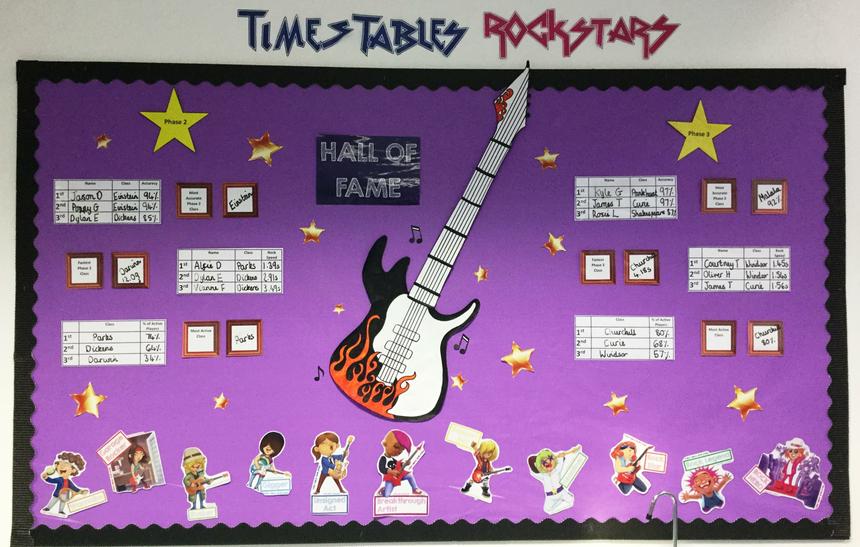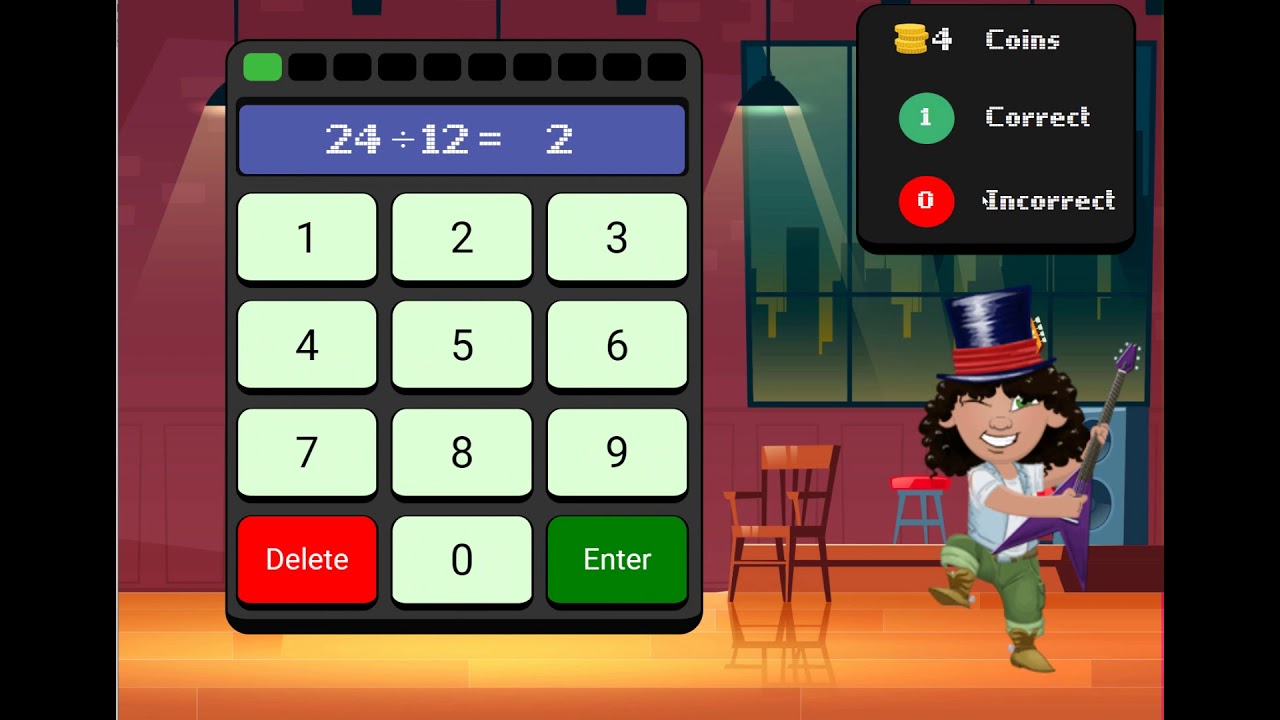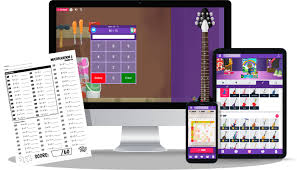Times Tables Rock Stars: Making Multiplication Fun
|
August 24, 2022
Complete 2025 guide to TTRS (Touch-type Read and Spell) for UK schools. Multisensory typing programme for dyslexia support. Pricing, features, and implementation tips.


|
August 24, 2022
Complete 2025 guide to TTRS (Touch-type Read and Spell) for UK schools. Multisensory typing programme for dyslexia support. Pricing, features, and implementation tips.
Times Tables Rock Stars is a weekly times tables programme designed to help children remember the multiplication tables. Children learn the tables in a sequence that builds up their ability to recall them. They are taught the basic facts about each product in turn, starting with 2 x 2 4 and ending with 12 x 12 144. There are no complicated calculations involved; just simple fact learning followed by repetition.
The programme is based on research carried out by Dr David Pritchard, Head of Mathematics Education at University College London. He found that students who practiced their times tables regularly had better recall of them than those who did not. As a result, he developed a method of teaching multiplication tables that built up the skill gradually.
Dr Pritchard tested his method in a pilot study involving 500 primary school children aged 7 and 8. After three months, the children who had learnt how to multiply quickly remembered the tables much better than those who had not. In 2008, Times Tables Rock Stars was launched in the UK. Over the next eight years, it has spread around the world, being used in classrooms throughout the US, Canada, Australia, New Zealand, South Africa, Malaysia, Singapore, Hong Kong and China.
In this programme, children learn the times tables in a sequence that helps them to build up their memory for them. The first lesson teaches the two-digit numbers from 2 x 2 4 onwards. This means that they can start multiplying any number of digits together without having to worry about remembering which digit goes where.
After this initial stage, the programme moves on to teach the four-digit numbers.These lessons include the addition of one or more digits to the end of the original number. For example, if you were to add 3 to the number 6, you would get 9. If you were to add 5 to the number 1, you would get 6.
Finally, the programme covers the twelve-digit numbers. It starts with the multiplication of two six-digit numbers (e.g. 24 x 32) and then moves on to the multiplication of two seven-digit numbers (e g., 72 x 92). The platform has a number of impressive features designed to keep pupils engaged in their learning. Using gamification, schools can create class competitions that keep track of individual scores. This type of incentive improves intrinsic motivation and consequently has a positive effect on the time learners spend studying their times tables. When schools shut their doors during lockdown, the reporting features provided teachers with important feedback about the progress their pupils were making.

There are many ways of teaching multiplication tables but most of these focus on memorising the tables rather than understanding what they mean.
For example, some programmes use flashcards to help children learn the tables. However, while this may be effective for short-term retention, it doesn't provide long-term benefits.
Other programmes involve complex calculation methods such as using a calculator. But again, although this might seem like an efficient way of teaching multiplication tables, it's actually quite difficult to do so accurately.
With TTRS, however, there is no need to calculate anything. Instead, the child learns the tables through a series of questions and answers. This allows them to understand exactly what the table represents. This quickfire approach turns retrieval practice into a daily learning habit that pupils can access from any internet-enabled screen.
This approach also works well when combined with another important aspect of TTRS - its structure. Unlike traditional programmes, TTRS uses a question-and-answer format. This encourages children to think logically and provides them with a framework within which to organise their knowledge. Times Table Rock Stars provides pupils time to develop their mathematical conceptual knowledge in a friendly manner. Online times tables competitions are a simple way of bringing fun to something that many pupils can often find laborious. Thousands of pupils use this platform to sharpen their mathematical skills and what's wrong with making it pleasurable (especially if they are willing to spend time doing this for homework!).

Executive functioning refers to a set of cognitive processes that are critical for higher-order thinking skills such as planning, problem-solving, and decision-making. Research has shown that executive functioning is closely linked to memory and attention, which are both important for successful learning. Touch-Type Read and Spell (TTRS) is a program that can help improve executive functioning and these essential cognitive skills in students.
TTRS uses a multi-sensory approach to repetition learning, helping students to memorize and recall multiplication tables and other mathematical skills. This approach, combined with retrieval practice, helps to reinforce learning and improve memory retention. The flexible approach of TTRS also allows for differentiation and personalized learning, adapting to each student's unique learning needs.
Furthermore, TTRS offers a range of accessibility features, such as adjustable speed settings and font sizes, making it an inclusive tool for all learners. The program's reporting features provide teachers with data on student progress, allowing for targeted support and intervention.
Incorporating TTRS into the classroom can benefit students by improving their executive functioning and higher-order thinking skills, leading to increased math mastery and academic success. By providing students with a fun and engaging way to learn multiplication tables and other mathematical skills, TTRS can help to improve focus, memory, and attention, while also promoting independent and self-directed learning.

Touch-type Read and Spell (TTRS) combines touch-typing with reading and spelling support, particularly effective for dyslexic learners.
TTRS uses a multisensory approach, teaching touch-typing whilst reinforcing phonics and spelling patterns. Particularly beneficial for students with dyslexia and other SpLDs.
Times Tables Rock Stars is a fun and engaging way to help primary school children improve their mathematical skills, particularly in the area of multiplication tables. The program takes a multi-sensory approach to tuition, using music and game-like features to help students memorize and recall multiplication tables more effectively. Here are some best practices and strategies for teachers to use when implementing Times Tables Rock Stars in the classroom:
1. Use Times Tables Rock Stars as a supplement to traditional teaching methods: While the program is effective on its own, it's best used alongside other teaching methods such as worksheets and practical exercises.
2. Set aside specific times for pupils to play: Give pupils time to use the program during class time or as part of homework assignments to ensure they are practicing regularly.
3. Provide feedback to pupils: Use the feedback tools within the program to provide constructive criticism and encouragement to pupils, helping them to improve their skills and gain confidence in their abilities.
4. Encourage friendly competition: Times Tables Rock Stars allows pupils to compete against each other, which can be a great motivator. Encourage friendly competition and recognize top performers to keep pupils engaged.
5. Use Times Tables Rock Stars as a tool for differentiation: The program adapts to individual pupils' abilities, making it a great tool for differentiated instruction.
By implementing these strategies and best practices, teachers can help their pupils improve their mathematical skills in a fun and engaging way. Times Tables Rock Stars is a fantastic resource for primary school children and can be a great addition to any teacher's toolbox.
TT Rock Stars is a global community of schools which support each others' efforts to improve student achievement through healthy competition. They encourage teachers to use the resources, including lessons and activities, to engage students in learning times tables. The aim is to raise attainment and inspire children to achieve their best.
TT Rock Stars is now part of the Teach To Reach organisation, which is supported by the Department for Education and Skills.
Times Tables Rock Stars is a weekly times tables programme designed to help children remember the multiplication tables. Children learn the tables in a sequence that builds up their ability to recall them. They are taught the basic facts about each product in turn, starting with 2 x 2 4 and ending with 12 x 12 144. There are no complicated calculations involved; just simple fact learning followed by repetition.
The programme is based on research carried out by Dr David Pritchard, Head of Mathematics Education at University College London. He found that students who practiced their times tables regularly had better recall of them than those who did not. As a result, he developed a method of teaching multiplication tables that built up the skill gradually.
Dr Pritchard tested his method in a pilot study involving 500 primary school children aged 7 and 8. After three months, the children who had learnt how to multiply quickly remembered the tables much better than those who had not. In 2008, Times Tables Rock Stars was launched in the UK. Over the next eight years, it has spread around the world, being used in classrooms throughout the US, Canada, Australia, New Zealand, South Africa, Malaysia, Singapore, Hong Kong and China.
In this programme, children learn the times tables in a sequence that helps them to build up their memory for them. The first lesson teaches the two-digit numbers from 2 x 2 4 onwards. This means that they can start multiplying any number of digits together without having to worry about remembering which digit goes where.
After this initial stage, the programme moves on to teach the four-digit numbers.These lessons include the addition of one or more digits to the end of the original number. For example, if you were to add 3 to the number 6, you would get 9. If you were to add 5 to the number 1, you would get 6.
Finally, the programme covers the twelve-digit numbers. It starts with the multiplication of two six-digit numbers (e.g. 24 x 32) and then moves on to the multiplication of two seven-digit numbers (e g., 72 x 92). The platform has a number of impressive features designed to keep pupils engaged in their learning. Using gamification, schools can create class competitions that keep track of individual scores. This type of incentive improves intrinsic motivation and consequently has a positive effect on the time learners spend studying their times tables. When schools shut their doors during lockdown, the reporting features provided teachers with important feedback about the progress their pupils were making.

There are many ways of teaching multiplication tables but most of these focus on memorising the tables rather than understanding what they mean.
For example, some programmes use flashcards to help children learn the tables. However, while this may be effective for short-term retention, it doesn't provide long-term benefits.
Other programmes involve complex calculation methods such as using a calculator. But again, although this might seem like an efficient way of teaching multiplication tables, it's actually quite difficult to do so accurately.
With TTRS, however, there is no need to calculate anything. Instead, the child learns the tables through a series of questions and answers. This allows them to understand exactly what the table represents. This quickfire approach turns retrieval practice into a daily learning habit that pupils can access from any internet-enabled screen.
This approach also works well when combined with another important aspect of TTRS - its structure. Unlike traditional programmes, TTRS uses a question-and-answer format. This encourages children to think logically and provides them with a framework within which to organise their knowledge. Times Table Rock Stars provides pupils time to develop their mathematical conceptual knowledge in a friendly manner. Online times tables competitions are a simple way of bringing fun to something that many pupils can often find laborious. Thousands of pupils use this platform to sharpen their mathematical skills and what's wrong with making it pleasurable (especially if they are willing to spend time doing this for homework!).

Executive functioning refers to a set of cognitive processes that are critical for higher-order thinking skills such as planning, problem-solving, and decision-making. Research has shown that executive functioning is closely linked to memory and attention, which are both important for successful learning. Touch-Type Read and Spell (TTRS) is a program that can help improve executive functioning and these essential cognitive skills in students.
TTRS uses a multi-sensory approach to repetition learning, helping students to memorize and recall multiplication tables and other mathematical skills. This approach, combined with retrieval practice, helps to reinforce learning and improve memory retention. The flexible approach of TTRS also allows for differentiation and personalized learning, adapting to each student's unique learning needs.
Furthermore, TTRS offers a range of accessibility features, such as adjustable speed settings and font sizes, making it an inclusive tool for all learners. The program's reporting features provide teachers with data on student progress, allowing for targeted support and intervention.
Incorporating TTRS into the classroom can benefit students by improving their executive functioning and higher-order thinking skills, leading to increased math mastery and academic success. By providing students with a fun and engaging way to learn multiplication tables and other mathematical skills, TTRS can help to improve focus, memory, and attention, while also promoting independent and self-directed learning.

Touch-type Read and Spell (TTRS) combines touch-typing with reading and spelling support, particularly effective for dyslexic learners.
TTRS uses a multisensory approach, teaching touch-typing whilst reinforcing phonics and spelling patterns. Particularly beneficial for students with dyslexia and other SpLDs.
Times Tables Rock Stars is a fun and engaging way to help primary school children improve their mathematical skills, particularly in the area of multiplication tables. The program takes a multi-sensory approach to tuition, using music and game-like features to help students memorize and recall multiplication tables more effectively. Here are some best practices and strategies for teachers to use when implementing Times Tables Rock Stars in the classroom:
1. Use Times Tables Rock Stars as a supplement to traditional teaching methods: While the program is effective on its own, it's best used alongside other teaching methods such as worksheets and practical exercises.
2. Set aside specific times for pupils to play: Give pupils time to use the program during class time or as part of homework assignments to ensure they are practicing regularly.
3. Provide feedback to pupils: Use the feedback tools within the program to provide constructive criticism and encouragement to pupils, helping them to improve their skills and gain confidence in their abilities.
4. Encourage friendly competition: Times Tables Rock Stars allows pupils to compete against each other, which can be a great motivator. Encourage friendly competition and recognize top performers to keep pupils engaged.
5. Use Times Tables Rock Stars as a tool for differentiation: The program adapts to individual pupils' abilities, making it a great tool for differentiated instruction.
By implementing these strategies and best practices, teachers can help their pupils improve their mathematical skills in a fun and engaging way. Times Tables Rock Stars is a fantastic resource for primary school children and can be a great addition to any teacher's toolbox.
TT Rock Stars is a global community of schools which support each others' efforts to improve student achievement through healthy competition. They encourage teachers to use the resources, including lessons and activities, to engage students in learning times tables. The aim is to raise attainment and inspire children to achieve their best.
TT Rock Stars is now part of the Teach To Reach organisation, which is supported by the Department for Education and Skills.